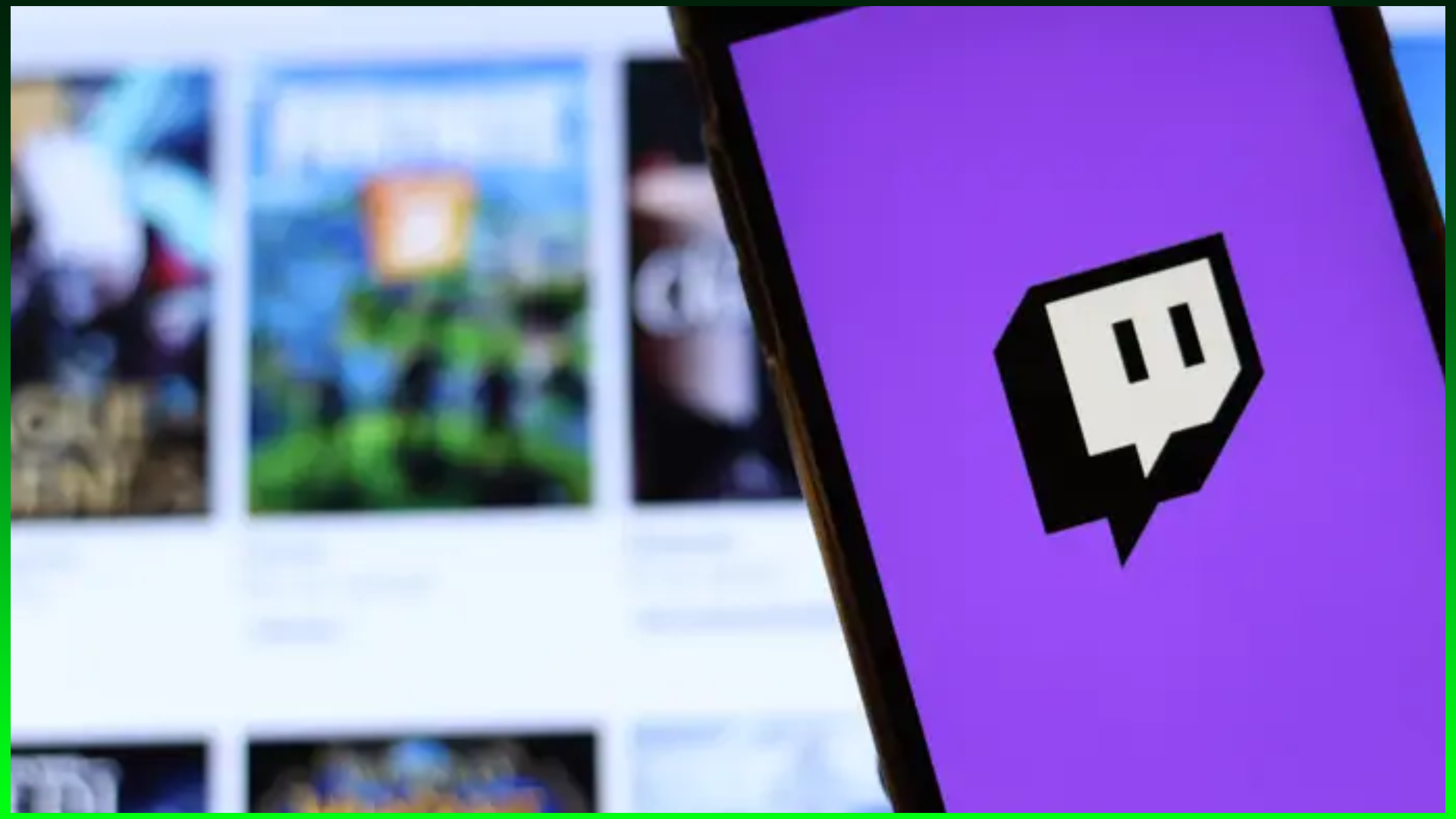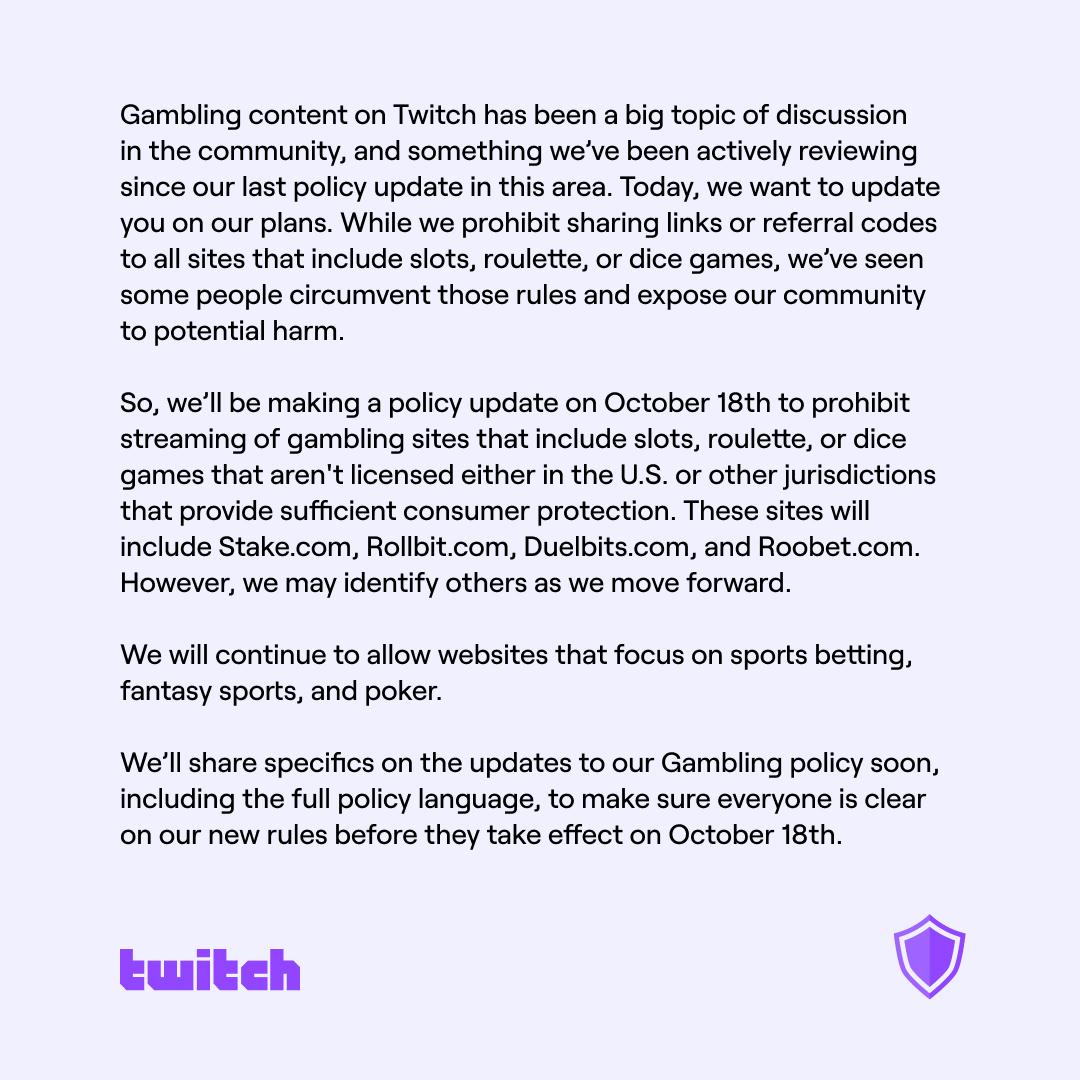I would like to say that the title is a little bit clickbait but as you read, you will see that is not the case and yet again, Twitch is in the spotlight not for one but for two situations and this is what happened in chronological order.
Twitch lay down limitation to gambling content
Starting next month, streamers will be banned from running gambling content from websites as Stake.com, Rollbit.com, Duelbits.com and Roobet.com and more to be added over time.
This is in response to the pressure that big names of Twitch are giving to the plattform as the rising of gambling content has led to people actually losing money and little have benefited from it and happens to be the gambling streamer and that Twitch needed to step up.
The event that triggered the pressure was an incident where streamer Sliker confessed that he scammed his followers and other Twitch streamers out of money in the video game Counter-Strike: Global Offensive raising over $200,000 to feed his gambling addiction but no context on how he will amend for his action.
Revenue handling is the major fire
This morning Twitch President itself, Dan Clancy, decided to do an entry on Twitch's official blog to talk about an important topic and it is about the new revenue formula.
Hello, Twitch community. I’m Dan Clancy, President of Twitch and responsible for the day-to-day operations of the service. FYI, this blog is targeted to streamers, but everyone is of course welcome to read along with us.
This morning we reached out to a subset of streamers about some upcoming changes to their agreement terms. This blog gives us an opportunity to be clear with all streamers on Twitch about those changes and talk more broadly about our strategy to help streamers make more money on our service.
Streamers are and always will be the foundation of our global community. It’s your passion, hard work, and creativity that make Twitch the one-of-a-kind place it is. To bring it back around more directly to this blog’s topic: we can’t run this service unless you make money. That’s not a drawback; it’s by design. This innate partnership is why we support all streamers’ careers and ambitions like they’re our own.
Before we talk about what’s happening next, we need to share some information for context.
For subscriptions, we use a baseline revenue share of 50/50 on the net revenue from those earnings. The vast majority of Twitch streamers have these terms in their agreement. However, for some time we did offer standard agreements with premium subscription terms to select streamers as they grew larger. This isn’t something we’ve talked about publicly, but such deals are common knowledge within the streamer community. Historically, we didn’t have a consistent framework to determine who would receive these deals and when. Over a year ago, we made the decision to begin to stop offering these premium agreements to new streamers not already on these terms.
As we reflected on how we handled these premium deals, we realized a few problems. First, we had not been transparent about the existence of such deals. Second, we were not consistent in qualification criteria, and they generally went to larger streamers. Finally, we don’t believe it’s right for those on standard contracts to have varied revenue shares based on the size of the streamer.
In an ideal world all streamers would be on the same set of terms regardless of size. However, instituting that policy would have a negative impact on the streamers currently on these terms, many of whom were instrumental in helping us build the Twitch we know today. These streamers have come to depend on the additional revenue split to maintain their standard of living.
For these streamers still on these premium deals, we’re adjusting the deal so that they retain their 70/30 revenue share split for the first $100K earned through subscription revenue. Revenue above $100K will be split at the standard 50/50 share split. We’re announcing this change now, but it won’t go into effect until after June 1, 2023. After that point, streamers will only be affected once their existing contract is up for renewal. All streamers with these terms have already received this information and more via email, and we will make sure to give them exact updates and timelines as we get closer to June 1, 2023.
For approximately 90% of streamers on standard agreements with premium subscription terms, this change will not affect them at their current revenue. For those who are affected, we wanted to make sure the impact was minimal — not just by giving them ample time before the deal goes into effect — but also by offering an alternative way to earn revenue. Our recent bump in ads revenue share to 55% as part of the Ads Incentive Program is a great way for these larger streamers to make up most, if not all, of that revenue. For those that are interested in additional detail, we have provided a copy of the email that we have sent to some of these streamers explaining the change and how it affects them below.
It’s a reality of our business that we will, in rare cases, continue to negotiate custom agreements on a case by case basis. However, we have been reducing how often we offer these deals and the total value of these deals.
Now, let’s get to the big question.
Why not 70/30?
When we first established a 50/50 revenue share split, it was to signal that we’re in this together. You all do the amazing work you do to create great content, engage with your audience, and grow communities. On our side of the partnership, it’s our responsibility to make continuous investments in the products and people that make your growth possible.
At the time of this posting, more than 22,000 of you have weighed in on UserVoice asking us to move all streamers to 70/30 and to pay streamers faster. Let’s chat about the latter part first.
As you probably heard by now, we’re in the middle of rolling out the largest change to payouts in years by cutting the payout threshold in half to $50. This is an important middle step that will help streamers put money in their pockets now, while getting us closer to our goal of same day payouts and lower thresholds.
Investments like these are paying off for streamers. Products like Prime Subs, Community Gifting, Hype Train, and the Ads Incentive Program, to name a few, have driven an increase of 27% more streamer revenue per viewer hour every year over the last five years. This means the same viewer hour now earns you three times more money than it did five years ago, on average. Our investments into your monetization options have already and continue to put more money into streamers’ pockets than 20% more subs revenue share would have.
Prime Subs often get lost in the conversation when it comes to revenue share. For Prime Subs, we pay streamers the same amount they’d receive for a regular subscription even though it is included as an added benefit of their Prime subscription. Combined with other monetization products, Prime Subs increase your effective revenue share by approximately 15%, to about 65% total. This number varies by streamer size and location, but subscription revenue share is not the full picture on revenue share for streamers.
Lastly, we have to talk about the cost of our service. Delivering high definition, low latency, always available live video to nearly every corner of the world is expensive. Using the published rates from Amazon Web Services’ Interactive Video Service (IVS) — which is essentially Twitch video — live video costs for a 100 CCU streamer who streams 200 hours a month are more than $1000 per month. We don’t typically talk about this because, frankly, you shouldn’t have to think about it. We’d rather you focus on doing what you do best. But to fully answer the question of “why not 70/30,” ignoring the high cost of delivering the Twitch service would have meant giving you an incomplete answer.
What’s Next?
When someone asks me why Twitch is the best place to make money as a streamer, my answer starts first and foremost with community. Community on Twitch is real and tangible, from chat memes to subscriber emotes to TwitchCon meetups, and yes — to how streamers earn money. That’s partially because of our work to equip you with the right tools, but it’s primarily because streamers like you are putting yourselves out there, embracing what you’re most passionate about, and building communities.
We believe we have the most compelling offering for streamers, and there’s still more we can do. The best Twitch is the one we build together, and your feedback helps us evolve in the right direction. As always, if you have any feedback, the best place to share is Twitch UserVoice.
Thank you for your time.
- Dan Clancy
Basically, after justifying their business model, Twitch won’t be giving out the 70/30 revenue split to everyone and while there will be special cases (big streamers that can make a big audience like it is a rockstar), it will NOT be the common thing.
For those who are on those agreements, Twitch will still honor them except when the revenue breaks the $100,000 barrier and then, the formula transforms to 50/50 with no space to appeal.
Basically a TLDR of the reasoning is the video hosting cost, yes you read right, an Amazon subsidiary needed to cut costs and the main reason to buy Twitch in the first place was to compete directly with YouTube.
The new Terms And Condition for monetization goes in effect on June 1, 2023 and talking about this now probably is to have the situation go silent by then, so let’s have the fire now.


